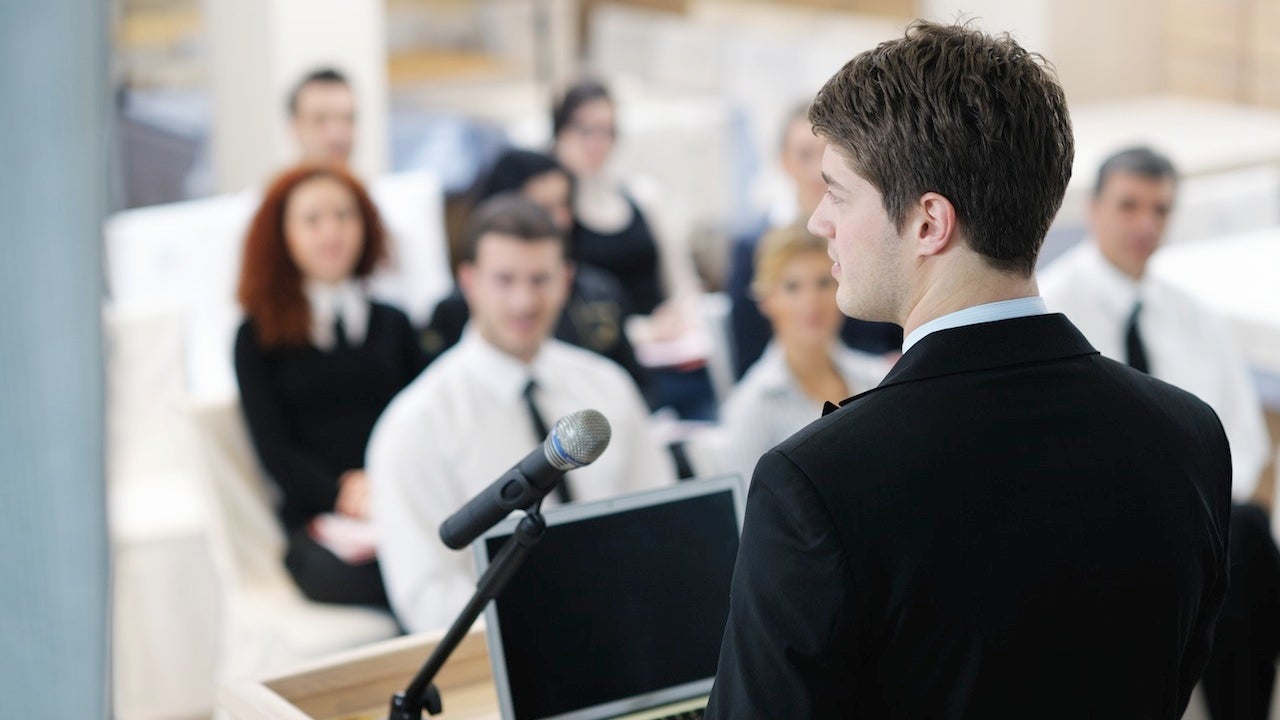Present Like A Boss

#ProPresenterTip: Create a user profile on your computer that is just for conferences. Personalize the desktop to a professional-looking theme or with elements relevant to the event. Remove all unnecessary programs, especially background programs. Disable auto-connect stuff to the internet. Create a folder on your desktop with your presentations and any files that are embedded in the presentation. Disable your screen saver and your power saver functions.
This way, when you hook up your laptop to a projector, you won't show any embarrassing or unprofessional desktop images, warning pop-ups, email notifications, etc. or have your screen go dark if you leave it sitting too long (and especially showing your login screen on a big screen for the whole room to see), and you won't have to search for your relevant files. This also reduces the memory requirements on your laptop so that it runs more smoothly.
The only thing you should have enabled in your presenter profile is your slideshow software and possibly the appropriate media player (but seriously, embed that shit instead of popping out to an external media player, and keep those files in the same folder as your slideshow). If you're doing something technical that uses the internet in your presentation, then you can have a browser enabled too, but otherwise, your presenter profile doesn't need internet access, email access, facebook access, virus protection & operating system update notices, power-saving mode, or password-protect. Strip it down to the absolute bare minimum.
Oh, and if you *are* using the internet in your presentation, double-check and get in writing before you even leave for the event that your room will have internet access in it, or make sure you have a damn good hotspot to use. And then test that shit the moment you arrive, not as you're running into your room 6 minutes late.
And if you can get artwork from the event itself to make into a desktop wallpaper, that makes those moments when your desktop *does* get broadcast on the big screen look less accidental and more professional. And for Loki's sake, leave off all those hundreds of shortcut icons! You don't need them here!
When you need to use your computer as normal, you can just log onto your regular user profile and have all your stuff back. But when it's hooked up to a projector, we don't need to see your wife's picture behind the field of shortcut icons or that your McAfee is out of date or that your brother-in-law just sent you a funny email forward.
AND BACK UP YOUR SHIT. Put all your presentations (and the embedded files) on a thumb drive as a backup. If, for any reason, your computer doesn't want to play nice with the A/V equipment, or you spill your vodka on it at the bar the night before and fry the circuits, or you forget your power cable and it runs out of battery, you might be able to find another laptop to use if you have your presentations available on a flash drive of some sort.
Create a PowerPoint Slideshow version of your presentation (as opposed to a full PowerPoint Presentation), whether you have Windows or you use Keynote. This embeds all your media better than the standard .pps file, and not everyone has a Mac that can run Keynote - you're much more likely to find a Windows machine and a PowerPoint Slideshow is self-contained so it can usually play even on Windows machines without PP installed (but you can't edit it).
Hook up your laptop to the projector in the room you'll be presenting in during a meal break or at the end of the day BEFORE your presentation, to make sure that everything works and everything talks to each other. As a professional PowerPoint operator*, the single biggest problem with slideshows is not testing beforehand. Almost everything can be fixed if you test it out ahead of time. But 3 minutes before your room is supposed to go is too late to troubleshoot bad cables or weird laptop settings. If it doesn't work at that time, then you're doing your presentation without your slideshow.
For even more tips on how to present, visit https://sites.google.com/site/polymediaassociation/trainingpresentations
*For those who don't know, I am actually a professional PowerPoint Operator. Yes, they have those, and yes, they pay me very good money to fix all the presenter fuckups. I get called in only for the very big shows, we're talking like Microsoft big - the kinds of shows where presenters are not some no-name monotone guy standing behind a podium in a dinky meeting room; the kinds of shows where the presenters are professional and have teleprompters and a team of 11-20 video professionals behind the scenes making everything look good.
Here's a secret about those shows - the presenter doesn't drive their own slideshows. They're holding a clicker, but the clicker just flashes a big green arrow at someone like me backstage and *I'm* the one who drives the deck. And I'm usually back there with 3 or more computers working in a team with professionally produced video and audio on seperate machines. I sit through hours of tech rehearsals going back and forth through the slideshows to make sure that every slide works as intended and that every cue is hit when it's supposed to be hit, and when it doesn't work, I'm there for hours after the presenter has gone to the bar to schmooze, working on their slideshow to get it to work. If you're reading my blog for advice, then you're probably not speaking at a show big enough to afford someone like me. So take tips from a professional in the business and make your presentations look like you're speaking at a show big enough to afford me.